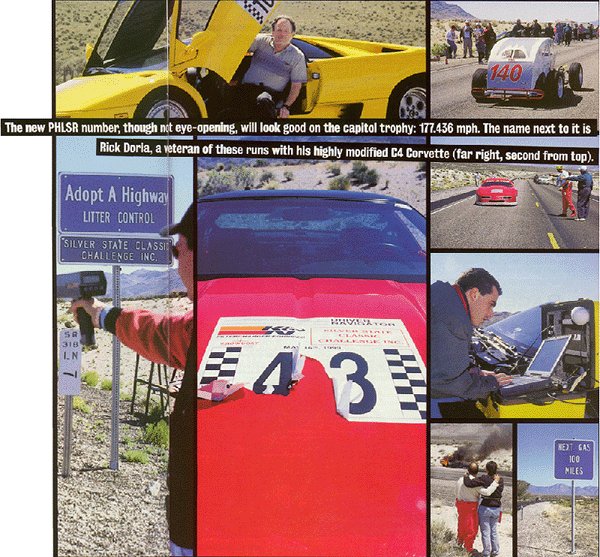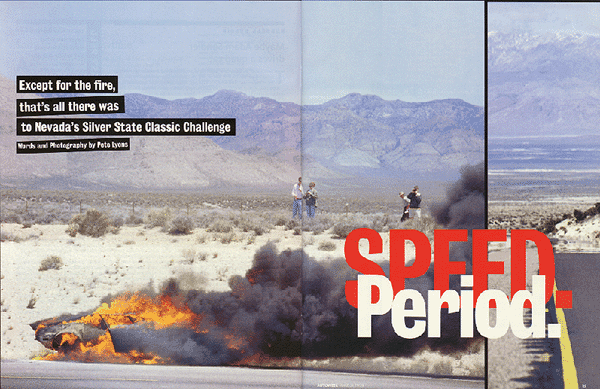 Mad Dog's beautiful black-and-gold1972 DeTomaso Pantera was already limned with flame when it shot
by the checkered flag. "Yeah, I kinda knew then," the driver admitted. "But I was focused on finishing." Mad Dog's beautiful black-and-gold1972 DeTomaso Pantera was already limned with flame when it shot
by the checkered flag. "Yeah, I kinda knew then," the driver admitted. "But I was focused on finishing."
If Mad Dog, aka Dennis Antenucci of Huntington Beach, Calif., lifted at all, wasn't much. According to Sean O'Leary,
the man holding the radar gun at the finish line, "He blew by at 170-plus. On fire." Distracted, he didn't
get a good reading. All he could do was whirl and watch the burning bullet streak on to the shut-down area and
the next human beings-and fire extinguishers-in sight, a long Nevada mile away.
Up to this point, the 20th Silver State Classic Challenge, a semiannual speediest along state highway 318 south
of Ely, had been going quite well. Nobody had crashed, at least not seriously. The field of 171 entries, with 155
actual starters (137 covered the full distance), was a record. So was any speed they set, thanks to a remeasured,
slightly revised course of 90.348 miles. (Previous records, including the 197.99-mph announced in 1989 over a distance
later found to be inaccurate, have been "retired.") Overall highest average mph would be commemorated
on a "Public Highway Land Speed Record" trophy to be displayed in the capitol at Carson City. The weather
was clear and cool. They even had a tail wind.
That was now working against Antenucci. So was the fact that the slow-down mile was all downhill. He'd lost his
brakes. The same thing had happened on the highway drive up here from California, and it crossed his mind that
maybe this time spurting brake fluid had caught fire. But he had a lot on his mind. Mainly, those extinguishers.
Spreading from the left rear, the fire was across the entire tail of the mid-engined Pantera by the time it was
200 yards from the hay bale chicane protecting the "pits."
His speed was down now. Down too much. Those last yards were going painfully slowly. With no brakes, no power either,
all he could do was use the last of his momentum to steer off the pavement and bail. As the car stopped, it erupted.
His cockpit engulfed in seething orange flames, it took the driver long, long moments to fight out of it and tumble
to the ground.
Meanwhile, a dozen of his fellow competitors bravely ran up with their own smallfire bottles. They bought him a
few seconds, but they were unable to save his car. As it burned to a hulk, Antenucci embraced his sobbing wife
and roared at the top of his lungs, "I'm lucky! I'm fine! Mad Dog's Immortal!"
Getting to feel like this is part of the reason racers race, though they hope not to test the matter so narrowly.
The new PHLSR number, though not eye-opening, will look good on the capitol trophy: 177.436 mph. The name next
to it is Rick Doria, a veteran of these runs with his highly modified C4 Corvette. Doria, of Newport Beach, Calif.,
said he was going as fast as 210 to 215, but was losing his transmission toward the end-"Our seventh trans
in six races."
Since AutoWeek's coverage of the inaugural Silver State in 1988 and the tragic second one in 1989, in which a passenger
died, the event has grown and grown up. The 1999 field was more than triple the 49 that started the first time
1 1 years ago. The SSCC organization went to a twice-yearly schedule in 1991 (this year's second date is Sept.
19; contact www.silverstateclassic.com or 1-702-631-6166). The group also participates in a long-established road race in Mexico,
while a rival body started by Indianapolis 500 champion Rodger Ward conducts a pair of similar events elsewhere
in Nevada, as well as one in Texas.
As popularity has swelled, safety requirements and procedures have been tightened. In fact, calling these events
"races" overstates the case for most competitors. Unless they're in the Unlimited class, it's more like
a TSD rally. Drivers name a target speed from 90 to 150, in 5-mph steps, and are scored on how precisely they hit
that average. Radar traps along the route, some hidden, threaten disqualification for anybody exceeding the target
by more than 30 mph. That margin, called the "Tech Speed," sets the highest mph that a car is considered
safe, given the safety equipment and tires installed.
The SSCC organization was using a new, GPS-based timing system on this occasion. Developed by Carl St-Onge of KLB
Informatique in Ste-Foy, Quebec, Canada, it uses only the clock signals from the global positioning satellite array
to synchronize laptop computers linked to electronic beams across the track. The system appeared to perform well
at the Silver State, eliminating a traditional uncertainty in contests where start and finish lines are many miles
apart.
For most entrants, their assigned speed is plenty. "Where else can I drive my car this fast?" pointed
out first-timer Joe Martz, a nuclear scientist from Los Alamos, N.M., whose target average was 140 mph in his Lamborghini
Diablo. "I'll be back."
So will fellow novice Bob Mahoney, a retired Internet entrepreneur who drove his Mercedes S600 from Milwaukee,
only to get T-boned at a Las Vegas intersection. "I got taken out by a Geo Metro," he recounted. "I
was going to go home, but I thought it would be more fun to rent a Ferrari. They were all out of Vipers."
Running the 125-mph class in a 348 whetted his appetite for more, he confirmed. "I've got a 911 twin-turbo
and I'm prepping it for September."
Veteran Carl Young also wanted to explain the special appeal of the Silver State. Owner of a Porsche service business
in Las Vegas and a member of the SSCC board, he has participated in every event-"Except the year I had a heart
attack the week before. The doctor wouldn't let me race." Not that he really thinks of it as racing, he adds.
"I've raced dirt track and sports cars. Also, I'm an ex-fighter pilot. I flew 500 combat missions in Vietnam
and enjoyed every one. I've pulled zero g over the tops of thunderstorms in formation with my flight leader going
'beep-beep-beep' on the radio like Sputnik, for fun. After that, how can you get excited about going 180 mph down
the road?
"But I do enjoy this," continued Young, who cruised down the road at 185 in his 993 turbo. "It's
a new experience with a new group of people."
There are SS racers who come to really race. However, only Unhmiteds are eligible to go for a trophy speed, and
they too have a limit unless they're using all-out race tires. Those on DOT-certified street rubber cannot exceed
the current Z-rating, which means 217 mph (350 km/h). Doria's Corvette had Michelin Pilots, which he chose instead
of his regular Hoosier race slicks because of road conditions.
The problem with the road was its new surface. Freshly laid just before last September's Challenge, it ruined that
event by being too soft and littered with loose, sharp-comered crushed stone. After one of the fastest cars, Kelly
Sievers' ex-Trans-Am Corvette, blew a slick, rolled and burned (the driver escaped unscathed), the remaining field
ran a short, token event.
By now the new surface should have been race-ready, and it was for every thing but an Unlimited on slicks. That,
at any rate, was the opinion of Kim Baker, veteran pro racer who was scheduled to drive potentially the fastest
car. One of his own former ZR-1 racing Corvettes now owned by Bill Kipp, it has a 540-cid Lingenfelter motor with
a nitrous oxide system that can make 900 horsepower. The crew says the car has been clocked at 252 mph, and was
hoping to see 260 this time.
"Not with me in it," said Baker, after closely inspecting the course. In his view, the ground-effects
nose piece and tall rear wing could force sticky slicks hard enough into the road to tear out the sharp stones
and possibly puncture a tire. Nor did he feel comfortable with the thought of the monster car on treaded DOT tires.
The team decided to wait for another day on another road.
Nor did John Hennessey run his Viper, while local star Sievers stayed home in Reno with bronchitis. In the end,
just six Unlimiteds ran out of the 11 entered, and only two finished. Second to winner Doria was James Weeks of
Pahrump, Nev., in an '84 Corvette resurrected from its role as a wreck in the 1994 movie Last Man Standing. Weeks
used Hoosier slicks-actually a model that comes with a very shallow, diagonal tread pattern-and had no trouble
with them, but never turned his 406-cid, 500-hp engine'over 5000 rpm, or 178 mph in top gear.
"I'm thrilled," he said. |
|

